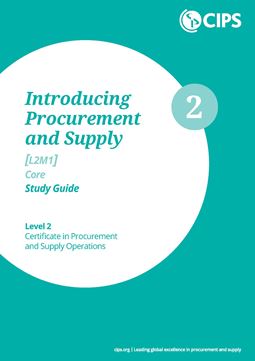
1.0 Understand the role of procurement and supply within organisations
1.1 Identify the common terms that describe aspects of procurement and supply
- Definitions of common terms such as procurement, purchasing, buying, supply chain, materials management, distribution, logistics and contract management
- Definitions of different types of procurements such as capital and revenue purchases, products, services, direct and indirect, outsourcing and insourcing
- Three sectors of activity: extraction of raw materials (primary), manufacturing (secondary), and services (tertiary)
1.2 Explain the roles and benefits of procurement and supply in organisations
- The typical proportion of costs accounted for by procurement of goods and services
- The roles of procurement and supply and procurement professionals
- Achieving value for money
- Sustainability in procurement and supply
- The roles of staff with devolved responsibilities for procurement of goods and services
- The roles of procurement and supply staff in making expenditures with suppliers
- The tiers of a supply chain
1.3 Define components of a supply chain
- Customers and their customers
- Customers and consumers
- Suppliers and their use of suppliers
- Tiers of a supply chain
- The global aspects of supply chains
- Examples of supply chains in action
2.0 Understand the organisational impact of procurement and supply
2.1 Identify how effective procurement impacts on organisational efficiency
- How effective procurement impacts on profitability
- Creating savings and improving efficiency
- Budgets and budget monitoring
- How effective procurement helps achieve targets
- Total costs of ownership criteria or whole life costs
- The different objectives of a procurement and supply function
- The creation of centralised, devolved and lead buying structures of procurement and supply functions.
2.2 Define the five rights of procurement and supply
- The five rights of procurement and supply
- Price, total cost, quality, timing, quantity and place
- Defining value for money
3.0 Know how products and services are received from suppliers and delivered to customers
3.1 Identify the delivery of products and services made by external suppliers
- The need for supplies of products and services from external suppliers
- Outsourced services
- Seeing suppliers as a part of a supply chain
3.2 Identify the delivery of products and services that organisations make to customers
- Defining products and services
- The customer role
- Seeing customers as a part of a supply chain
4.0 Know the stages of the sourcing process
4.1 Indicate stages of a sourcing process
- Identification of needs
- Producing specifications
- Requesting quotations
- Receiving quotations
- Assessing supplier quotations
- Making contract award recommendations
- Contract authorisation
- Order placement, blanket orders/frameworks and call off orders
- Performance and delivery
- Payment of suppliers
- Expediting deliveries
- Reviewing outcomes and processes
- Pre and post award stages of a sourcing process
5.0 Understand the need for the effective and efficient administration of purchases made with external suppliers
5.1 Describe and explain effective and efficient administration
- Defining administration
- Reviewing the steps taken to forming agreements made with suppliers
- Defining effectiveness and efficiency
5.2 Describe the administration of the pre contract stages of a sourcing process
- The creation of requisitions and requirements
- The use of specifications, key performance indicators (KPIs) and contract terms
- The creation of requests for quotations or invitations to tender
- The use of prequalification questionnaires
- The submission of quotations or tenders for requirements
- The assessment of quotations and tenders
5.3 Describe the administration of the award and post award stages of a sourcing process
- The creation of orders or tender award documentation
- Delivery notes and order acknowledgements
- Receiving invoices
- Invoice matching and dealing with non-compliances
5.4 Explain the need for approvals in the administration of procurement and supply
- Typical procedures for authorising budgets, requisitions, orders and tenders
- The separation of duties
- Contract recommendation and authorisation
- Levels of delegated authority for contracts
- Ensuring an efficient approval process
6.0 Know the importance of ethics and responsible procurement in organisations and supply chains
6.1 Identify good ethical practices and procedures within the context of the procurement and supply function
- Application of the CIPS Code of Conduct
- Details included in ethical codes affecting procurement and supply
- The use of ethical codes of practice
- The use of documented policies and procedures for the work of procurement and supply
- The principles of corporate governance
- Forms of bonded and exploitative labour that can exist in supply chains
